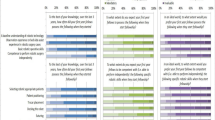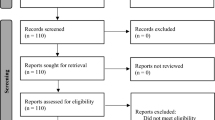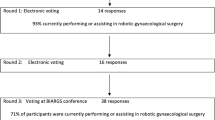Abstract
The objectives of the study were to describe robotic-assisted surgery training programs currently being used by ACGME-accredited obstetrics and gynecology (OB/Gyn) residency programs and to explore residents’ attitudes towards their robotic surgery training curricula to evaluate resident desire for robotics training. We conducted a cross-sectional study of OB/Gyn residents for the 2015–2016 academic year. Participants completed a 31-item online questionnaire regarding their robotic-assisted surgical training and associated perspectives. Analyses of these data were primarily descriptive. In total, 98.9% of included respondents (N = 177) reported availability of a surgical robot at their training institution, and 35.0% of participants reported not having any structured robotics training program at their institution. The most commonly used training modalities included online modules (62.2%), dual-assist console (55.1%) and virtual reality simulation (50.3%). The most commonly reported barriers to completing a robots training were a lack of personal time (56.2%) and availability of the virtual reality simulator or access to the robotic equipment (29.2%). OB/Gyn residents desire robotics training and are exposed to a wide variety of training modalities. The ACGME should consider recommending the incorporation of a standardized formal robotics training program as part of the OB/Gyn residency curriculum.


Similar content being viewed by others
References
Lee J (2015) Modern healthcare [internet]: crain communications. http://www.modernhealthcare.com/article/20150113/NEWS/301139973. Accessed 13 April 2016
Robotic Surgery in Gynecology (2015) ACOG committee opinion no. 628. American College of Obstetricians and Gynecologists. Obstet Gynecol 125(3):760–7
Schreuder HWR, Wolswijk R, Zweemer RP et al (2012) Training and learning robotic surgery, time for a more structured approach: a systematic review. BJOG 119:137–149
Gobern JM, Novak CM, Lockrow EG (2011) Survey of robotic surgery training in obstetrics and gynecology residency. JMIG 18:755–760
Smith AL, Schneider KM, Berens PD (2010) Survey of obstetrics and gynecology residents training and opinions on robotic surgery. J Robot Surg 4:23
Vetter MH, Green I, Martino M, Fowler J, Salani R (2015) Incorporating resident/fellow training into a robotic surgery program. J Surg Oncol 112(7):684–689
Patel YR, Donias HW, Boyd DW, Pandea RU, Amodeo JL, Karamanoukian RL, D’Ancona G, Karamanoukain HL (2003) Are you ready to become a robo-surgeon? Am Surg 69:599–603
Thiel DD, Patel VR, Larson T, Lannen A, Leveillee RJ (2013) Assessment of robotic simulation by trainees in residency programs of the Southeastern Section of the American Urologic Association. J Surg Educ 70(5):571–577
Vogell A, Gujral H, Wright KN, Wright VW, Ruthazer R (2015) Impact of a robotic simulation program on resident surgical performance. AJOG 213:874–875
Sheth SS, Fader AN, Tergas AI, Kushnir CL, Green IC (2014) Virtual reality robotic surgical simulation: an analysis of gynecology trainees. J Surg Educ 71:125–132
Crusco S, Jackson T, Advincula A (2014) Comparing the da Vinci si single console and dual console in teaching novice surgeon suturing techniques. JSLS 18(e2014):00218
Liang MI, McCann GA, Rath KS, Backes FJ, Cansino C, Salani R (2014) Training the next generation of robotic surgeons using guided mentorship: a randomized controlled trial. JMIG 21(6):1075–1079
Fernandes E, Elli E, Guilianotti P (2014) The role of the dual console in robotic surgical training. Surg 155(1):1–4
Farviar BS, Flannagan M, Leitman IM (2015) General surgery residents’ perception of robot-assisted procedures during surgical training. J Surg Educ 72:235–242
Arain NA, Dulan G, Hogg DC, Rege RV, Powers CE, Tesfay ST, Hynan LS, Scott DJ (2012) Comprehensive proficiency-based inanimate training for robotic surgery: reliability, feasibility and educational benefit. Surg Endosc 26(10):2740–2745
Winder JS, Juza RM, Saski J, Rogers AM, Pauli EM, Haluck RS, Estes SJ, Lyn-Sue JR (2016) Implementing a robotics curriculum at an academic general surgery training program: our initial experience. J Robot Surg 10(3):209–213
Author information
Authors and Affiliations
Corresponding author
Ethics declarations
Conflict of interest
Drs. Vetter, Hade, Fowler, Salani and Ms. Palettas declare they have no conflict of interest.
Ethical approval
All procedures performed in studies involving human participants were in accordance with the ethical standards of the institutional and/or national research committee and with the 1964 Helsinki declaration and its later amendments or comparable ethical standards.
Informed consent
Informed consent was obtained from all individual participants included in the study.
Rights and permissions
About this article
Cite this article
Vetter, M.H., Palettas, M., Hade, E. et al. Time to consider integration of a formal robotic-assisted surgical training program into obstetrics/gynecology residency curricula. J Robotic Surg 12, 517–521 (2018). https://doi.org/10.1007/s11701-017-0775-0
Received:
Accepted:
Published:
Issue Date:
DOI: https://doi.org/10.1007/s11701-017-0775-0




